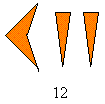

Likewise, an irregular fraction is a fractional number with non-terminating sexagesimal expansion.

If n’ has a finite sexagesimal expansion, then we say that n is regular. The reciprocal of a number n is just n’ := 1/n. Instead, they based their computations on the concept of reciprocal numbers.

They did not have a special symbol corresponding to the decimal point, nor did they have anything like our modern fraction notation. The Babylonians also understood the concept of fractions, or ratios. They used place value notation for larger numbers and fractional numbers just as we do now, except that they did not have a symbol for zero to indicate empty place values. The Babylonians had cuneiform symbols for 1 and 10, which they combined like tally marks to express numbers between 1 and 59. For example, the number 4000 would be expressed as 1,6,40 = 1 x 60^2 + 6 x 60 + 40 x 1 in sexagesimal notation. That is, the place values corresponded to postive and negative powers of 60. Perhaps the most widely known fact about Babylonian mathematics is that it used an artificial sexagesimal number system. Often, though, the problems are pedagogical in construction, and so the input values are skillfully chosen to provide a clean answer. What was the initial ration?’ In modern notation, the problem asks to solve for s in the equation (1-2/9)s = 7.Ĭontrary to the preceeding example, Babylonian math problems can be quite complicated, involving large numbers and multiple unknowns (sometimes as many as fifteen - see Friberg, pg. This is not to say that Babylonian mathematicians did not understand the abstract principles behind their solutions they simply thought of them in the context of concrete examples, similar to the way a mechanic might think of physics principles in terms of an automobile.Īn example of such a concrete mathematical text comes from YBC 4669, which states : ‘2/3 of 1/3 of my ration I have eaten. Thus there are very few instances of Babylonian ‘proofs,’ or even instruction tablets that outline a general method for solving a class of problems. There are many examples of texts dealing with more general geometric or algebraic problems, but they are usually stated in terms of concrete situations such as the division of a field or distribution of rations, and are always discussed using specific values. Other texts describe fairly realistic situations that might arise in economic exchanges or engineering endeavors, such as constructing dams, canals, and brick walls. Many texts from that era are simply multiplication tables of various sizes, designed to aid scribes in performing complicated arithmetic. Instead, it focused on practical problems that could be solved algorithmically. Unlike classical Greek mathematics, Babylonian mathematics was not centered around geometric figures or abstract proofs of mathematical theorems. However, if we are to judge by the number and age of the cuneiform mathematical texts we possess, it appears that mathematics reached its apex during the Old Babylonian period.Īt the outset, it should be mentioned that Babylonian mathematics was largely an applied science. The copy-paste of the page "Babylonian Numerals" or any of its results, is allowed as long as you cite dCode!Ĭite as source (bibliography): Babylonian Numerals on dCode.Mathematics was an active discipline in Mesopotamia since the earliest periods of writing in the mid-fourth millennium BC. The copy-paste of the page "Babylonian Numerals" or any of its results, is allowed as long as you cite the online source
Babylonian numerals solver android#
Except explicit open source licence (indicated Creative Commons / free), the "Babylonian Numerals" algorithm, the applet or snippet (converter, solver, encryption / decryption, encoding / decoding, ciphering / deciphering, translator), or the "Babylonian Numerals" functions (calculate, convert, solve, decrypt / encrypt, decipher / cipher, decode / encode, translate) written in any informatic language (Python, Java, PHP, C#, Javascript, Matlab, etc.) and all data download, script, or API access for "Babylonian Numerals" are not public, same for offline use on PC, tablet, iPhone or Android ! Ask a new question Source codeĭCode retains ownership of the "Babylonian Numerals" source code. Convert the Babylonian numbers to Hindu-Arabic numerals (1,2,3,4,5,6,7,8,9,0), then use the Roman numeral converter of dCode.


 0 kommentar(er)
0 kommentar(er)
